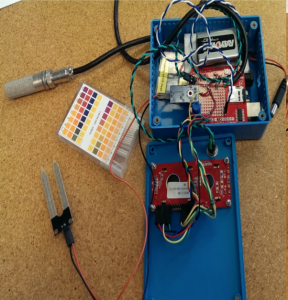I have been weighing the options of testing soil in the field vs. on the bench for parameters of interest. The parameters I am focusing on are soil ph, temperature, moisture, fertility, conductivity and organic content. Of these seven, only temperature and moisture must be collected in the field. I believe that the others can be more accurately determined in a bench-top environment. I am developing my hardware designs accordingly. The next steps for me are to track down materials to build this ph probe and figure out how to interface it with an arduino board and relay information back to the field science android app through bluetooth. I am also planning to have a conversation with Mike Deibel this week about using optical measurements for organic content and fertility tests (and possibly munsell color tests). I also have a back-burner interest in geophysical surveying techniques for archeological dig sights that is still very much in the research stage.
“Science in a Box” Soil Platform
My current project is to develop a functional and consistent set of sensors and protocols to collect information about important soil parameters such as pH, fertility, conductivity, temperature, organic content, and moisture. In Iceland and Nicaragua, the approach was to construct a unified soil sensor platform using Arduino and Yoctopuce technology that takes readings in the field.
The potential benefits of this approach are that every parameter of interest is collected in the field and immediately saved in .csv format on a nexus device. The downside is that it is not particularly easy (or in some cases, possible) to test every parameter in harsh environments accurately or without causing damage to the sensors.
With this in mind, I am planning to take a sightly different approach: a sensor for use in the field that measures parameters that must be collected in situ (such as temperature and moisture), supplemented by benchwork preformed in the evening to collect other relevant soil parameters. The evening benchwork would also have hardware and software components. For example LED/photometer sensors could be used to measure organic content and other optical sensors could be used to make observations about the color of the soil and its composition.
The next steps for me are:
- Learn more about the chemistry of soil fertility and ph and find a way to test them cheaply without using standard kits.
- Consider the hardware element. Look for cheap sensors that are compatible with Arduino boards and begin preliminary designs. I will probably build the temp/moisture sensor first since it most closely follows the paradigm of sensors that have already been developed as a part of this research.

